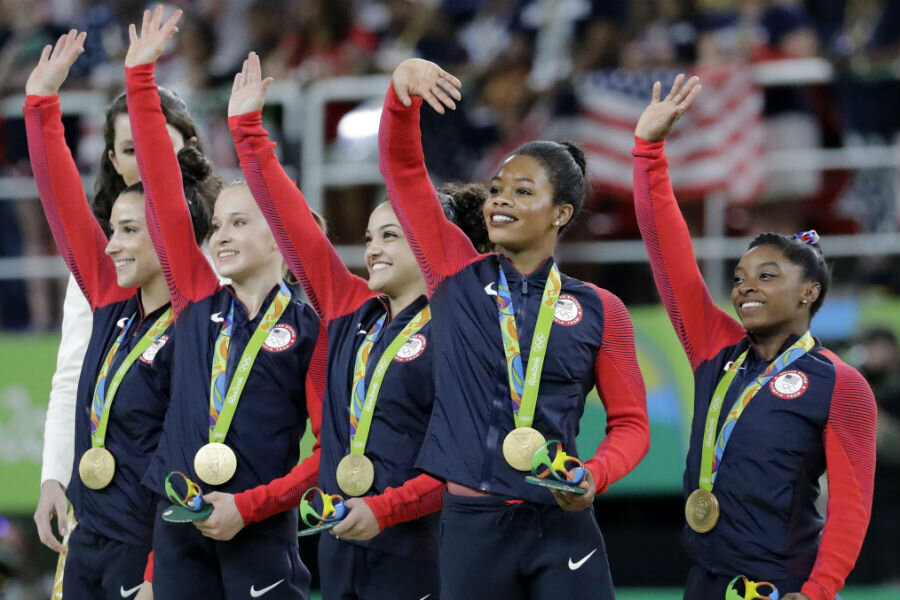Media coverage of female Olympians is typical, but viewers' responses are not
Loading...
First, there was outrage when an NBC commentator referred to swimmer Katinka Hosszu's husband and coach as "the guy responsible" for her gold medal and new world record in the 400-meter individual medley last Saturday.
The next day, another NBC commentator said the US women's gymnastics team "might as well be standing in the middle of a mall," setting off a flurry of angry tweets.
Then, on Sunday, social media was quick to respond to the Greeley Tribune in Colorado when it headlined an Associated Press story with "Phelps ties for silver in 100 fly," followed by the subhead "Ledecky sets world record in women's 800 freestyle" after Katie Ledecky won gold in her event.
Amid a series of high-profile media gaffes deemed misogynistic by many, coverage of female Olympians in Rio de Janeiro this year may be best summed up in Dickensian terms. As Cheryl Cooky, associate professor of American Studies at Purdue University in Indiana, puts it: "It was the best of times, it was the worst of times."
On the one hand, female Olympians are receiving more media coverage than in years past. That could be in part because a record number of female Olympians are competing in Rio. On the other hand, critics say, that coverage often relies on stereotypes by focusing on appearance, using infantilizing language, and referring to female athletes in terms of their roles as mothers, wives, or girlfriends.
The nature of the coverage, denounced as sexist by many, isn't anything new, says Dr. Cooky.
However, "what has changed is the response to it," she tells The Christian Science Monitor in a phone interview. "And there's something that's really interesting about this particular moment."
Media coverage seen as demeaning toward female athletes has received greater backlash this year than in Olympics past, as angered viewers speak out against broadcast commentary and headlines that they see as contributing to gender inequality in the sports world. Experts say the increased awareness may be because of a number of cultural factors.
One thing that's different this time around: "the proliferation of social media," Jaime Schultz, a sports historian at Pennsylvania State University, tells the Monitor in an email.
Social media, Dr. Schultz says, can be a double-edged sword, as "it allows for outlets to circulate absurd comments without really thinking about the content." She cites as an example a Chicago Tribune tweet about Corey Cogdell-Unrein, winner of the bronze medal in women's trap shooting, which read "Wife of a Bears' lineman wins a bronze medal today in Rio Olympics."
And then, of course, Schultz says, "there are the everyday trolls who think it's fair game to criticize [American gymnast] Gabby Douglas's hair or [Mexican gymnast] Alex Moreno's body."
But at the same time, "social media has also been a tremendous asset in term of drawing attention to the sexism we're seeing," she adds. Social media campaigns such as #CovertheAthlete, which urges media outlets to focus on women's athletic accomplishments rather than their appearances, "make us more aware of just how rampant these types of attitudes are."
The backlash also may reflect a "broader cultural moment right now where issues of women's equality are becoming more mainstream" thanks to outspoken celebrity feminists such as Emma Watson, Beyonce, and Taylor Swift, Cooky points out.
Marie Hardin, dean of the College of Communications at Pennsylvania State University, attributes the heightened attention to the issues facing female athletes in Rio to the current presidential campaign.
"Sports and politics have long been tied together – a lot of the qualities we see as making great leaders are those we see in sports," Dr. Hardin says in an email to the Monitor. "But more importantly, Hillary Clinton's candidacy has prompted discussions about women's issues and rights across a number of sectors in society, so awareness of these issues around the biggest sports event on the planet right now isn't surprising at all."
The Olympics are an especially important platform for promoting gender equality in sports, Hardin says, as the Games are "the best it's going to get for media coverage of female athletes – they don't get any greater, positive media attention than when they win on the world stage."
Coverage of male and female athletes is relatively equal during the Olympics: In analyzing the 2014 Sochi Olympics, researchers found only a 10 percent gap favoring male athletes. In contrast, another study of routine, non-Olympic sports media coverage in 2014 found that ESPN's "SportsCenter" dedicated only 2 percent of its sports coverage to female athletes, with three local Los Angeles network affiliates dedicating 3.2 percent.
"Part of the problem, I think, is that it’s very tough to 'get it right' when you're really concentrating on doing it once every two years, when the Olympics roll around," Hardin says. "This is where our general lack of attention to women's sports in general is apparent – media producers simply aren’t 'practiced enough' in strong, stereotype-free coverage to do it consistently well on the world stage for two weeks. It’s like asking an athlete to perform well after not practicing proper technique."








